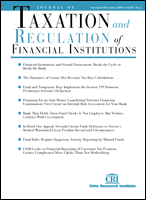Complete Issue
Author: Houman B. Shadab.
Source: Volume 28, Number 02, November/December 2014 , pp.1-52(52)

< previous article |return to table of contents
Abstract:
In our first article, Jon P. Brose discusses implications of Revenue Ruling 2014-18 for fund managers. As Mr. Brose explains, the Ruling allows managers to structure tax efficient compensation arrangements that satisfy investor demands for structures that better align managerial incentives. The rewards and potential dangers of regulated financial institutions using social media are addressed by Timothy R. McTaggart and Yuliya Benina in our second article. The authors discuss the supervisory guidance issued by the Federal Financial Institutions Examination Council, focusing on specific areas such as compliance and legal risk, personal information/privacy, and recordkeeping. Continuing with the theme of technology, in our third article Obrea Poindexter and Ryan H. Rogers cover the regulatory landscape for mobile financial services. Noting that technology has changed the ways consumers make payments and access other financial services, the authors discuss potential regulatory issues and the gaps that currently exist, and also summarize various responses to the June 12, 2014, request for information from the Consumer Financial Protection Bureau. Our fourth article discusses the “safe harbor” for historic tax credit investors—i.e., entities that provide funds to rehabilitate historic buildings. Peter J. Berrie discusses the August 2012 Third Circuit decision Historic Boardwalk Hall, which held that an investor was not a partner because it “lacked a meaningful stake in the success or failure” of the project owner, and the Internal Revenue Service’s guidance, issued on December 30, 2013, which provides a safe harbor based on the investors’ and principals’ minimum interest in the project. Philip R. Stein, in our fifth article, discusses the current state of fair lending laws. Mr. Stein notes that in the wake of the financial crisis and the subsequent Dodd-Frank Act of 2012, lenders are subject to regulation under fair lending laws and Dodd-Frank’s prohibition of unfair, deceptive, or abusive acts and practices (UDAAP). He discusses the evolving aspects of fair lending regulation, including recent litigation, and offers compliance strategies to help companies to avoid running afoul of the rules. This issue concludes with a state and local column by David A. Froling and Jeffrey Allen Miller. The authors discuss financial institutions’ tax sharing agreements in light of the Ohio Financial Institutions Tax that went into effect on January 1, 2014 and a June 12, 2014, update to a federal bank regulators policy statement.Keywords: Revenue Ruling 2014-18; social media; Federal Financial Institutions Examination Council; mobile financial services; historic tax credit safe harbor; fair lending laws; UDAAP; Ohio Financial Institutions Tax
Affiliations:
1: New York Law School.